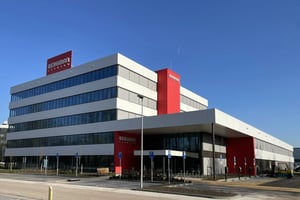In order to feed the growing world population, we will have to produce as much food in the next 40 years as we have over the past 8,000 years. The eyes of the world are on the Netherlands when it comes to the global food issue. This is because the country plays a pioneering role in developing new agriculture and horticulture techniques. From vertical agriculture to digital phenotyping: the agro-tech sector is standing on the threshold of major breakthroughs. An overview of the key developments.
It is, along with climate change, one of the greatest challenges of our time: producing and distributing enough food to feed the growing world population. Authorities in the field expect the global population to reach nearly ten billion by 2050. In order to keep pace with this growth, all agricultural sectors will have to collectively scale up production substantially. Solutions will also have to be found for a range of thorny related problems such as huge levels of food waste in primarily the Western world, food distribution in third-world countries, erosion of agricultural land and the manure issue.
The agricultural sector is actively developing solutions to meet these challenges on numerous fronts. Technology plays a leading role in this endeavour. Read any international publication on this relatively young sector, which is known as agro-tech in the Netherlands and AgTech internationally, and you are bound to come across the name Wageningen University & Research. This educational institution is not only one of the few to offer a special Bachelor’s Degree programme in Agrotechnology, it also provides accommodation for numerous startups that are developing innovative and sustainable technology for the production of food and other agricultural products (such as algae for fuel). They benefit from the fact that the Dutch government has designated Agrofood and Horticulture & Propagation Materials as so-called top sectors and makes subsidies (seed money) available to carry out feasibility studies and develop business cases. An overview of the key developments in this field in the Netherlands is provided below.
1. Precision agriculture
The agriculture of the future will see various types of sensors placed strategically around the fields. This will make it possible to monitor crops remotely and give them precisely the treatment that is needed. Watering and fertilisation can be optimised per crop and per field in real time. This will result in higher food production and less loss. The sowing and harvesting machinery is also becoming increasingly smarter. This will enable more precise planting (optimum yields per square metre) and accurate forecasting of the yield and harvest. Wageningen University & Research is closely involved in the National Smart Farming pilot project (NPPL) that was launched last year.
2. Drones and crop monitoring
Drones are already used on a large scale in the US for crop monitoring as a tool that enables an effective response to drought or insect plagues for example. This will become standard practice in the future. Drones are currently being developed that can evaluate the soil quality based on a 3D image and, following analysis, calculate the optimum planting pattern. Drones are also increasingly used to spray precision-dosed crop protection substances so they do not seep into the groundwater. Recent studies have shown that drones can carry out this process up to five times faster than standard machinery, resulting in up to 90% savings on pesticides. Drones play a key role in the Fruit 4.0 project, a collaboration of the Dutch Fruit Growers Association (NFO) and Wageningen University & Research. Blossom and fruit development in the orchards are monitored using Kinect cameras, which enables more targeted fruit thinning (partially picking unripe fruit in order to improve the quality – ed.) and better harvest prognoses.
3. Robotics
While still in its infancy, experiments with robots that can identify and remove weeds independently using laser and camera guidance are being conducted at various locations around the world. The same robots can also be used to plant and water cuttings. While this is not yet possible, it’s only a matter of time given the fast pace of technological developments in grip and image recognition technology: robots that can independently pick vegetables and fruit according to their ripeness. Something that has already become a reality: Wageningen University & Research has, as part of the PicknPack EU project, developed a fully automated solution that can place vine tomatoes from harvest crates into consumer packaging. A robot has also been developed in Wageningen that can determine the perfect point to cut roses for automated planting of cuttings and a robot that can sort tomato cuttings fully automatically according to quality (i.e. a 3D analysis of the structure of the plant).
4. RFID sensors and tracking
RFID sensors are already used extensively to track containers from the grower to the auction/end customers in various sectors, including the cut flower sector. Wider application of RFID technology in the agricultural sector could enable optimum quality distribution and help fight food waste. The success of this currently depends on the cost price: the more parameters that have to be measured (e.g. temperature, relative air humidity, oxygen and carbon dioxide, ethylene and pH), the more expensive the technology. This is why Wageningen University & Research is working on the development of an affordable technological solution to this issue: an RFID that monitors the chain conditions of individual items of fruit and vegetables using intelligent tracking and subsequently predicts the shelf life. This requires a breakthrough in the field of multi-sensor technology, energy consumption, costs and structure.
5. Breeding
While breeding is as old as humanity itself, the arrival of AI and Machine Learning has driven the growth of biotechnology to the next level. Big data analysis of sowing, growth and harvest data make it possible to predict which qualities and genes are the best for the production of specific crops, meaning farmers worldwide continually have access to the best breed for their location and climate. Breeding is also the key to much more efficient stock breeding because it enables the selection of breeds that have an optimum feed/growth ratio. Big data also plays an increasingly important role in this regard. There are always tens of breeding projects underway at Wageningen University & Research, which are not always aimed at the usual suspects. The AF16202-MIP projects focuses on breeding seaweed for example. This is because large-scale seaweed cultivation is not yet profitable in Western Europe. The innovations that emerge from this project should bring about a change to this by reducing the production costs and increasing the economic proceeds. The aim of the four-year programme is to turn seaweed into a new sustainable source of healthy nutrients, nutritional additives and animal feed through sustainable seaweed cultivation in Dutch waters.
6. Vertical urban agriculture
Startup KeyGene is testing the latest inventions in the field of agriculture on plants in the Crop Innovation Center, a brand new research centre on the outskirts of Wageningen. One of those techniques is vertical agriculture, which entails cultivating crops above each other instead of next to each other. It also uses LED light in specific light wavelengths for optimum growth. Research furthermore shows that plants produce antioxidants under certain light wavelengths, which in theory makes it possible to grow additionally nutritious or more resistant plants using special light receptors. While vertical agriculture isn’t yet a feasible solution in terms of price, it seems likely that it will hold the future in urban agglomerations. For example, AeroFarms in the US opened a 6,500 m² vertical farm in New York in 2016. The farm now produces nearly a million kilos of vegetables for the local market every year. GROWx, a vertical farm that is the first to run completely on renewable energy, was recently opened in Amsterdam.
7. Digital phenotyping
Digital phenotyping (plant phenotyping) is defined as the fully automatic analysis of the growth and health of crops. Plants are grown in moving stands that are brought into a photo space on a conveyor belt. A computer then takes a photo of each plant, analyses it in real time and automatically enters measuring data on its growth in the system. These measurements are made during multiple development phases of the plant. Plant phenotyping is a new field of research that has attracted a great deal of interest both in the academic world and the industry, especially among breeders. Multiple consortiums in the academic world are working on developing infrastructure for plant phenotyping on a large scale. Wageningen University & Research serves as a knowledge partner in almost all cases.
Also read: Big data and artificial intelligence take animal genetics to the next level













